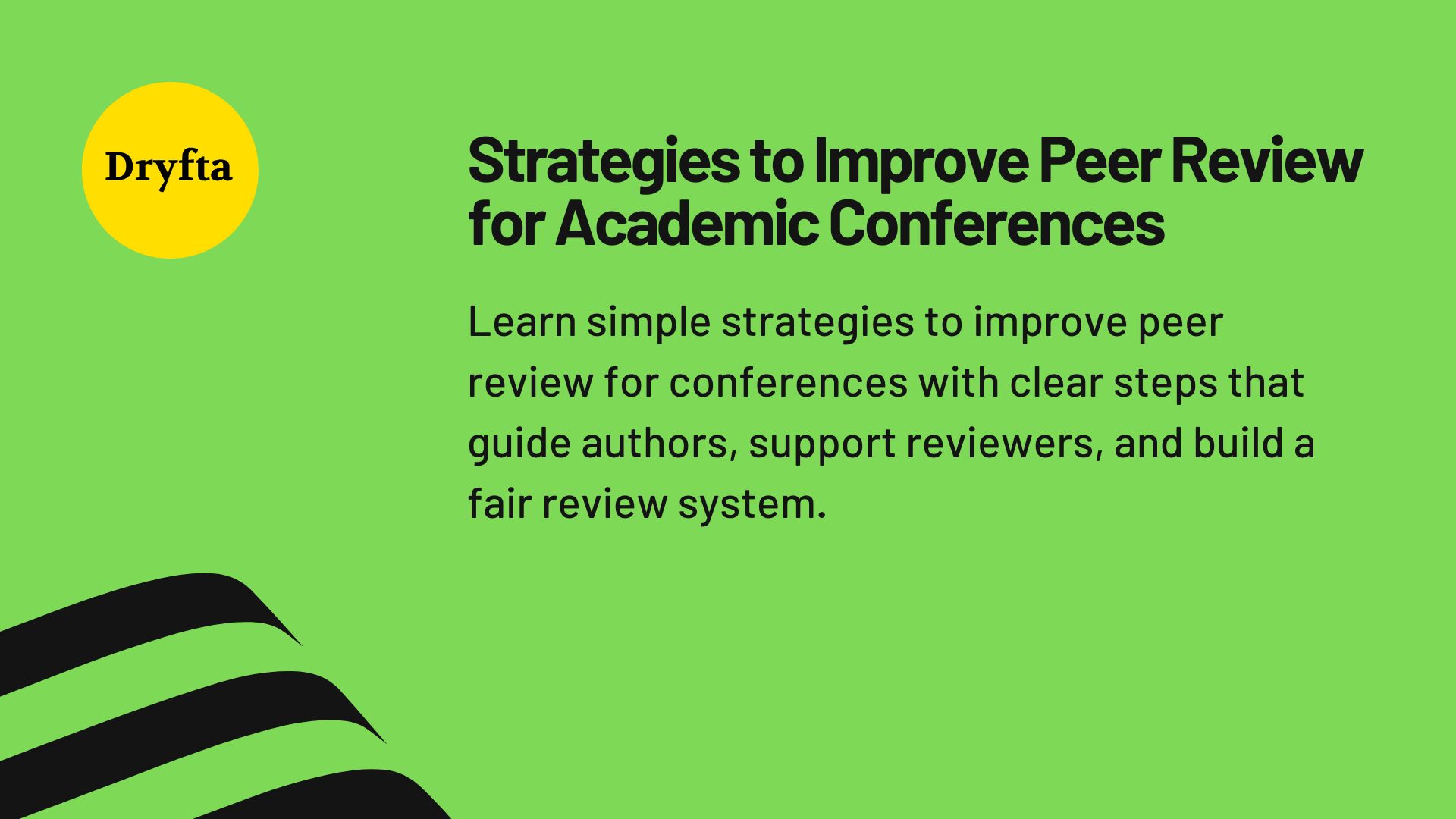
If you’ve been part of academic conferences for a while, you know that managing submissions and reviews can get complex. The peer review component is one of the most important parts of successfully hosting an academic conference. Authors submit their abstracts to be reviewed; reviewers read, score, and share comments for each submission. If the workflow is organized, all parties stay on track. However, when the workflow is disorganized, the entire review process becomes slow and stressful for authors, reviewers, and organizers alike.
As conferences grow in size, the abstract review process becomes more complicated to manage. You deal with a higher volume of submissions, more reviewers involved, and tighter deadlines. Thus, even slight breakdowns in your planning may lead to delays or inefficiencies. A strong peer-review system is important for helping you avoid these problems because it provides a transparent, equitable, and manageable process for each phase.
This guide explains how to improve the peer review process with strategies that support both authors and reviewers. The goal is to help you build a smooth, easy process from submission through to final decision, even if you have never managed peer review before.
What Does Peer Review Mean in Academic Conferences?
Peer review is a quality control process that supports academic conferences. It is an evaluation in which experts review and assess the papers submitted for inclusion in the conference program. Their goal is to check the relevance, accuracy, and worthiness of all submissions prior to inclusion into the event’s program. The term “peer review” can seem quite intimidating to many because of its formal tone. However, peer review is simply an evaluation of a submission by someone with knowledge about the subject matter to ensure quality.
Peer review also shapes the overall program. Well-written papers create a solid foundation for conference sessions and discussions, and enhance the learning of all attendees. Conference teams depend on clear reviews because the reviewers help them choose which papers fit the event.
Most importantly, peer review helps authors to grow. A reviewer’s feedback will show where the work is strong and what could be improved. Over time, authors become better writers, better researchers, and better thinkers.
How Does the Peer Review Workflow Usually Work?
1. Paper Submission
The author uploads an abstract or paper to the academic conference system. The review team receives the file in the main review queue.
2. Assigning Reviewers
The conference team assigns each manuscript submitted for review to at least two reviewers who understand the subject area. Each reviewer gets access through the system.
3. Reviewers Read the Work
Peer reviewers evaluate the paper’s content to see if the author has clearly, correctly, and effectively expressed their idea. They also evaluate whether there are good parts of your paper and what could be improved upon.
4. Reviewers Give Scores and Comments
Reviewers share their comments that guide the author toward better writing, as well as a grade that helps the conference team determine the overall quality.
5. Conference Team Studies the Reviews
Each reviewer’s grade is collected by the system so that the conference team has full insight into the papers before making the final decision.
6. Decision Sent to Author
The author gets one of three results. The paper may either be accepted, rejected, or returned to the author to revise and resubmit. This feedback helps the author improve their work.
7. Revision (If Needed)
Some conferences ask for follow-up drafts, which they have revised in some way, to be sent to the reviewers. These follow-up drafts are reviewed and confirmed by the reviewers to ensure the new version of the work is enhanced.
8. Final Acceptance
Once a paper has been approved, it is included in the event program. In preparation for this, authors prepare their presentations for speaking at the event, creating posters for display, or preparing sessions for attendees.
This complete workflow gives structure, keeps the event fair, and helps the peer review team manage each paper with care.
Strategies to Help Reviewers Do Better Work
Provide Simple Review Guidelines and Scoring Tools
Reviewers are most productive when they have a clear review checklist or scoring tool prior to reviewing submitted papers. Using such tools will help reviewers to stay focused on the critical aspects of each submission, such as originality, relevance, and clarity.
This increases the consistency in the quality across evaluations, gives reviewers more confidence, and ensures fairness in evaluating each submission.
Limit Reviewers’ Load for Peer Review
When a reviewer receives an excessive number of papers, the overall quality of that reviewer’s feedback will likely decline, as well as create a time delay. A good system keeps the number of abstracts per reviewer small and realistic. This helps reviewers stay focused and give high-quality, thoughtful feedback.
Match Submissions to Reviewers’ Expertise
The review process works better when papers go to people who understand the subject. When the match is poor, the feedback can feel shallow or off-track. A simple way to improve this is to let authors pick topic areas during submission and let reviewers choose their areas of strength when they join. Matching these two sets of information leads to better reviews, fairer results, and a stronger final program.
Keep Workloads Balanced and Deadlines Clear
According to the American Society of Mechanical Engineers (ASME) peer review policy, when assigning reviewers and setting their timetables, ASME must adhere to those reviewers’ workloads to ensure the quality of the reviews.
When reviewers have a balanced workload, they are less likely to be fatigued, will remain focused on each submission, and provide authors with helpful feedback rather than hasty comments.
Provide reviewer support, training, and recognition
Reviewers give their time and effort, so support matters. When organizers provide this support, reviewers feel valued, complete their assignments on time, and the conference maintains its schedule. Simple guides, short training notes, or examples of good feedback also help reviewers feel confident in their role.
Strategies to Make Submissions Easier for Authors
Provide clear guidelines for peer review
Authors need simple rules that they can follow without much confusion. A clear guide tells them what the conference needs. The guide lists the page limit, format, topic rules, and key dates. This reduces the number of errors and the time authors might need to spend seeking assistance from support staff.
Offer Easy-to-Use Templates
Templates remove many of the early problems authors face during the submission. They guide authors on layout, headings, spacing, and file structure, thereby reducing formatting issues. Reviewers then receive files with the same structure, which speeds up and standardizes their reading. A good template also lowers stress for first-time authors who may not know the expected format.
Set Simple File Rules
File submission guidelines ensure authors have no trouble uploading files that open smoothly. The guidelines should provide clear guidance on acceptable file formats, naming conventions, and file sizes to limit the number of corrupted or unreadable files.
Authors move through the steps without technical delays, and reviewers get clean files that are easy to access on any device. By doing so, conference teams can manage submissions without spending time fixing avoidable mistakes.
Send Deadline Reminders
Deadline reminders support authors who juggle research, classes, and travel. A simple reminder prior to deadlines allows authors to stay on track. This reminder system eliminates the last-minute rush, which can cause authors to submit their papers late.
Keep the Submission Portal Easy to Navigate
When authors feel that the submission system is user-friendly or has a “clean” design, it drives them to submit their work in less time. This also reduces the number of support questions and frees up time for the organizing team. Reviewers will also benefit from receiving submissions in an organized format that is easily tracked within the submission system.
How Dryfta Supports Peer Review
-
- Dryfta gives you a simple tool for abstract submission and peer review. You can collect papers, assign reviewers, track each review, and notify authors in one place.
- The platform lets you set your own form fields, file rules, deadlines, and reminders. You can shape the system so authors follow your event guidelines with ease.
- Dryfta keeps all event data in one dashboard. You can view author details, reviewer notes, scores, and decisions in a clean layout. This helps the organizing team stay on top of the workflow without juggling spreadsheets.
- Dryfta easily assign abstracts to several reviewers in minutes using automated matching (based on your chosen criteria) or quick manual bulk assignment tools.
- Dryfta gives you a simple tool for abstract submission and peer review. You can collect papers, assign reviewers, track each review, and notify authors in one place.
Ending Notes
A clear peer review process helps a conference run with as little stress and as few delays as possible. When every step feels simple to follow, both reviewers and authors stay focused on their work. This creates a fair system where strong submissions increase naturally, and weaker ones improve through valuable feedback. A smooth workflow also helps the organizing team stay calm during busy weeks because each stage moves forward without confusion.
This type of workflow is supported by Dryfta. The platform brings all aspects of submissions, reviews, communications, and decision-making into one place. With Dryfta, your team can easily monitor each file, deadlines, and each reviewer’s comments, which leads to a less cumbersome process for the entire peer review cycle. Schedule a demo today to see how Dryfta’s abstract management system simplifies the peer review process.




